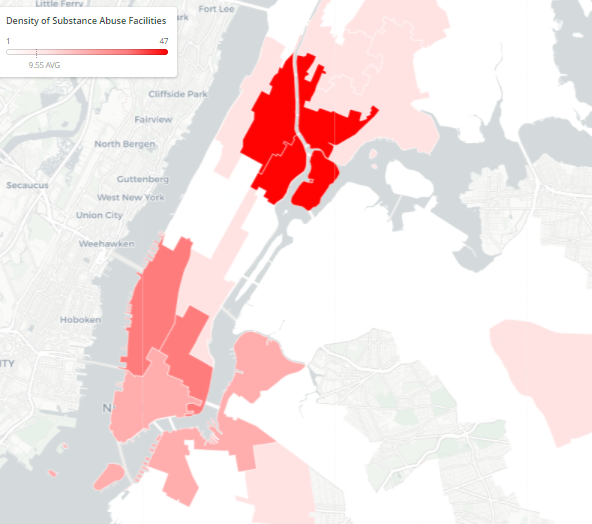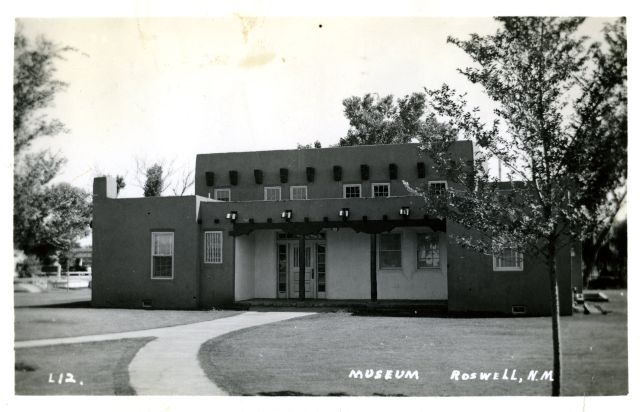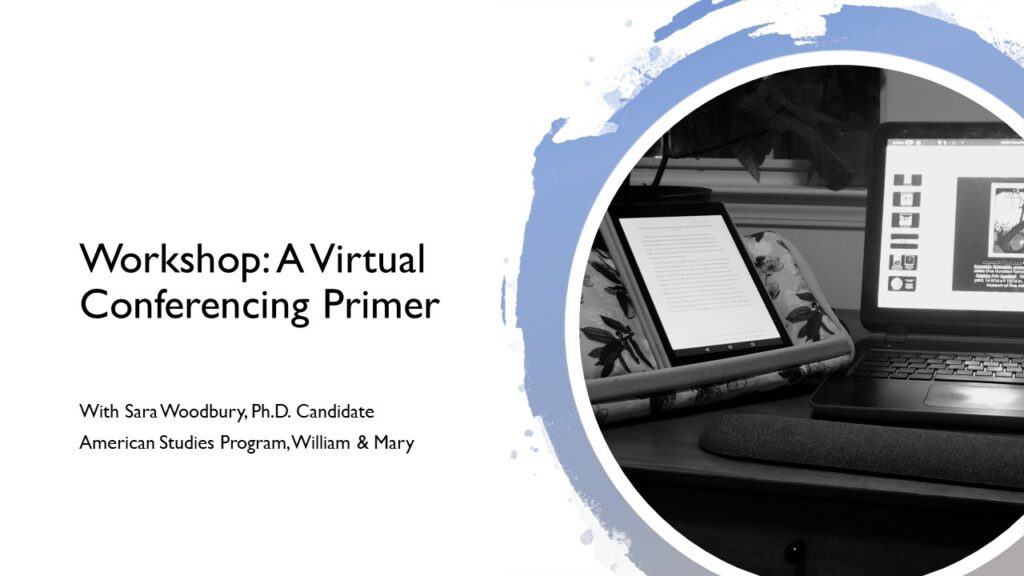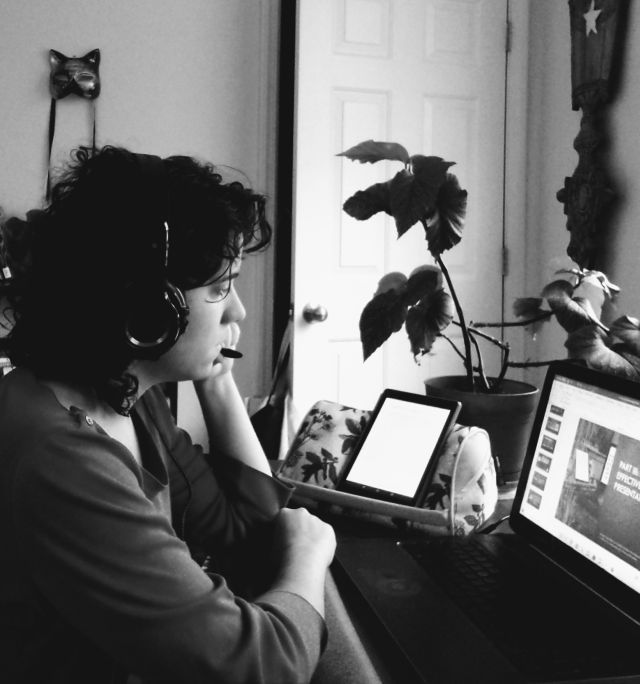Nearly one year ago, I started spending almost all of my time at home due to the pandemic and the resulting needs for stay-at-home orders, mask-wearing, and virtual work. Working at home, however, doesn’t mean I’ve been entirely disconnected from the broader academic communities at William & Mary and beyond. While most of my time these days is dedicated to the dissertation, exhibition research, and sketching, I’ve also been sharing my experiences virtually through different platforms. Today then, I’d like to take about my recent activity with the Equality Lab and the Chesapeake Digital Humanities Consortium.
Let’s talk about the Equality Lab first. In addition to offering symposia such as Finding Home, the Equality Lab also provides workshops on digital humanities methods and techniques. Last semester, two of my William & Mary colleagues, Ravynn Stringfield and Laura Beltran-Rubio, offered workshops on using social media platforms such as Twitter and Instagram for scholarly work. On February 19, I presented my own workshop on virtual conferencing.
I offered to do this because of my own experiences with virtual conferences. Last year I presented at two events, Museum Exhibition Design: Histories and Futures, and SECAC 2020, and I learned a lot about giving presentations online as opposed to in-person. Over the course of the workshop, I described the differences between synchronous and asynchronous conferences, offered strategies for putting together effective presentations online, and suggested different ways to record presentations and render them accessible through closed captions and image descriptions. I also offered recommendations for avoiding burnout during virtual conference participation, such as choosing the sessions that best fit your interests and focusing only on those, rather than trying to attend everything. A lot of my suggestions, such as including slides of direct quotations and reading from a script as opposed to an essay, could be applied to in-person conferences as much as virtual experiences. Others, such as testing your microphone before recording, or using a default image rather than a blank slide so that viewers don’t accidentally think that their screen has stopped working, were more specific to virtual presentations.
Overall, this was a pragmatically-minded workshop that focused on concrete approaches to designing virtual presentations, and attendees said they got a lot out of it. Nevertheless, there are definitely ways I could improve the workshop in the future. Since I had only done prerecorded conference papers up to that point, I didn’t talk about live presentations that much. I’ve given live talks since that time though, and I’ve learned that they offer their own challenges, so I’d definitely address them if I were to offer this again.
We recorded the workshop for those who couldn’t attend, and as soon as it’s available, I’ll add a link.
After the workshop, I had another opportunity to present my work virtually by participating in the 2021 Symposium for the Chesapeake Digital Humanities Consortium, which happened on February 25 and 26. I took part in that event last year, and as I wrote in another blog post, I really enjoyed having the opportunity to learn about great projects, listening to seminal digital humanists such as Dr. Catherine Knight-Steele, and getting helpful feedback about my own ideas.
This year offered another great selection of speakers and projects. Not surprisingly, perhaps, given the symposium’s theme of social justice, a lot of the presentations focused on the pandemic, with discussions ranging from the COVID Tracking Project, which collects data on rates of testing, among other things, to creative responses to the pandemic. These latter papers were particularly interesting, with subjects ranging from Christina Han’s exploration of COVID-19-inspired acrostic poems from South Korea, to Katie Kuiper’s analysis of pandemic-related messaging from the CDC and WHO on Twitter.

Other projects focused on different social justice issues, such as Shawn Hill’s presentation on the Greater Harlem Coalition and the inequities that have developed in relation to substance abuse treatment facilities. This presentation was particularly effective for me because it underscored the harm of the “not in my backyard” mentality that I read about during my comprehensive exams, with white property owners consistently rejecting legislation to open treatment facilities in their neighborhood. The result is that centers occupy Black communities disproportionately, with residents from across NYC having to commute significant distances for treatment. Dealers, in turn, frequent these neighborhoods because they know their clientele is concentrated there, perpetuating a vicious cycle between treatment centers, substance abuse, and perceptions of Black communities and other nonwhite neighborhoods beings unsafe and undesirable.
Another facet that I really appreciated about this year’s symposium was the number of international speakers, particularly concerning projects happening outside of the more overrepresented United States and Europe. Madhu, for instance, talked about digital activism among dalits in India, bringing attention to the systemic inequities of the caste system, while Camila Lamartine Barbosa discussed social media efforts to highlight the harassment of Brazilian immigrant women in European countries, arguing that this abuse reinscribes colonial and gendered hierarchies. As someone who openly admits that my current research is US-centric, I really appreciated that the CDHC expanded representation in its symposium beyond the US-European sphere.

For my part, I discussed my Scalar project on the Roswell Museum and Art Center. Compared to a lot of the other initiatives, my project is notably more modest in scale, but I wanted to demonstrate what students and other scholars can potentially accomplish on a platform like Scalar for a digital humanities seminar. I also wanted to show how DH and archival theory helped shift my focus away from simply relating the history of the museum to critically assessing its archive as a repository with respect to representation. Finally, I showed how I used Scalar to reorganize the archive to focus on labor, with documents sorted according to the employees they referenced rather than the people who wrote them, taking a cue from Foucault’s idea of untethering documents from authorship to create new relationships among them. Personally, I don’t think this was my most engaging presentation, as I’ve been prioritizing dissertation work, but I think attendees still got something out of it.
Based on these experiences, I’ll admit that I prefer giving prerecorded talks rather than live sessions. As someone who tries to cater my presentations to the interests and energy of the room, it’s unnerving to not be able to see everyone’s faces or read their reactions, especially if they’ve turned off their cameras. In all fairnness, you’re also talking to the void in prerecorded sessions, but for me, having a live audience without being able to see or hear them that well makes me more self-conscious than if I’m talking by myself. If I’m going to talk to a void, I’d rather do it knowing I’m alone rather than wondering who is out there and what they’re thinking. Then again, I’m also more practiced in prerecorded presentations, whereas these latest sessions were entirely new for me. Now that I’ve tried it out, I have a much better idea of what to expect for next time. Just knowing that will make my next live presentation more effective.
Overall though, my virtual workshop was a good experience for me, and I really enjoyed listening to all of the presentations at CDHC, both for their content and for the important questions they asked regarding equity, representation, and the humanity of data. All in all, not a bad way to spend two Friday afternoons.


